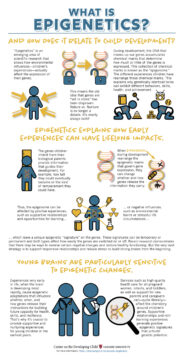Epigenetics and Child Development: How Children’s Experiences Affect Their Genes

This page has been translated.
View full text of the graphic
New scientific research shows that environmental influences can actually affect whether and how genes are expressed. In fact, scientists have discovered that early experiences can determine how genes are turned on and off and even whether some are expressed at all. Thus, the old ideas that genes are “set in stone” or that they alone determine development have been disproven. Nature vs. Nurture is no longer a debate—it’s nearly always both!
More Information on Epigenetics
Working Paper 10: Early Experiences Can Alter Gene Expression and Affect Long-Term Development
This in-depth working paper explains how genes and the environment interact, and gives recommendations for ways that caregivers and policymakers can effectively respond to the science.
During development, the DNA that makes up our genes accumulates chemical marks that determine how much or little of the genes is expressed. This collection of chemical marks is known as the “epigenome.” The different experiences children have rearrange those chemical marks. This explains why genetically identical twins can exhibit different behaviors, skills, health, and achievement.
Correcting Popular Misrepresentations of Science
Until recently, the influences of genes were thought to be set, and the effects of children’s experiences and environments on brain architecture and long-term physical and mental health outcomes remained a mystery. That lack of understanding led to several misleading conclusions about the degree to which negative and positive environmental factors and experiences can affect the developing fetus and young child. The following misconceptions are particularly important to set straight.
- Contrary to popular belief, the genes inherited from one’s parents do not set a child’s future development in stone.
Variations in DNA sequences between individuals certainly influence the way in which genes are expressed and how the proteins encoded by those genes will function. But that is only part of the story—the environment in which one develops, before and soon after birth, provides powerful experiences that chemically modify certain genes which, in turn, define how much and when they are expressed. Thus, while genetic factors exert potent influences, environmental factors have the ability to alter the genes that were inherited. - Although frequently misunderstood, adverse fetal and early childhood experiences can—and do—lead to physical and chemical changes in the brain that can last a lifetime.
Injurious experiences, such as malnutrition, exposure to chemical toxins or drugs, and toxic stress before birth or in early childhood are not “forgotten,” but rather are built into the architecture of the developing brain through the epigenome. The “biological memories” associated with these epigenetic changes can affect multiple organ systems and increase the risk not only for poor physical and mental health outcomes but also for impairments in future learning capacity and behavior. - Despite some marketing claims to the contrary, the ability of so-called enrichment programs to enhance otherwise healthy brain development is not known.
While parents and policymakers might hope that playing Mozart recordings to newborns will produce epigenetic changes that enhance cognitive development, there is absolutely no scientific evidence that such exposure will shape the epigenome or enhance brain function. What research has shown is that specific epigenetic modifications do occur in brain cells as cognitive skills like learning and memory develop, and that repeated activation of brain circuits dedicated to learning and memory through interaction with the environment, such as reciprocal “serve and return” interaction with adults, facilitates these positive epigenetic modifications. We also know that sound maternal and fetal nutrition, combined with positive social-emotional support of children through their family and community environments, will reduce the likelihood of negative epigenetic modifications that increase the risk of later physical and mental health impairments.
The epigenome can be affected by positive experiences, such as supportive relationships and opportunities for learning, or negative influences, such as environmental toxins or stressful life circumstances, which leave a unique epigenetic “signature” on the genes. These signatures can be temporary or permanent and both types affect how easily the genes are switched on or off. Recent research demonstrates that there may be ways to reverse certain negative changes and restore healthy functioning, but that takes a lot more effort, may not be successful at changing all aspects of the signatures, and is costly. Thus, the very best strategy is to support responsive relationships and reduce stress to build strong brains from the beginning, helping children grow up to be healthy, productive members of society.
For more information: Early Experiences Can Alter Gene Expression and Affect Long-Term Development: Working Paper No. 10.


